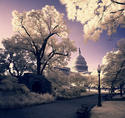The Census results are out for Illinois, and it's bad news for the city of Chicago, whose population plunged by over 200,000 people to 2,695,598, its lowest population since before 1920. This fell far short of what would have been predicted given the 2009 estimate of 2,851,268. It's a huge negative surprise of over 150,000, though perhaps one that should have been anticipated given the unexpectedly weak numbers for the state as a whole that were released in December. read more »
Demographics
A Leg Up: World's Largest Cities No Longer Homes of Upward Mobility
Throughout much of history, cities have served as incubators for upward mobility. A great city, wrote René Descartes in the 17th century, was “an inventory of the possible,” a place where people could lift their families out of poverty and create new futures. In his time, Amsterdam was that city, not just for ambitious Dutch peasants and artisans but for people from all over Europe. Today, many of the world’s largest cities, in both the developed and the developing world, are failing to serve this aspirational function. read more »
China Housing Market More Stable Than You May Think
The sensationalist reporting of rising China tends to celebrate the country’s ascent. But there is one area where both economists and casual observers see a potential disaster: the real estate market. Media reports of skyrocketing housing prices in first tier cities like Beijing and Shanghai and photo essays of Chinese ‘ghost cities’ inject sober skepticism into the otherwise bewildering reality of rapid growth. read more »
America's Biggest Brain Magnets
For a decade now U.S. city planners have obsessively pursued college graduates, adopting policies to make their cities more like dense hot spots such as New York, to which the "brains" allegedly flock.
But in the past 10 years "hip and cool" places like New York have suffered high levels of domestic outmigration. Some boosters rationalize this by saying the U.S. is undergoing a "bipolar migration"--an argument recently laid out by Derek Thompson in The Atlantic. read more »
Australia's Housing Affordability "Outrage"
There is mounting concern in Australia about the nature and extent of country’s housing affordability crisis. Expressions of distress are not limited to the middle income households who are locked out of the Great Australian Dream of home ownership. There is heightened interest from advocates of low income households and an opposition political party. Moreover, Australia's overvalued housing is receiving renewed attention in international circles. read more »
A New Tribe for New Geographies: Reasonable People of Goodwill
I am Singaporean, with a half-Indian, half-Eurasian father; a half-Pakistani, half-Malay mother. Dad converted to Islam from Roman Catholicism; each year my brothers and I celebrate Eid ful Fitr, Eid ul Adha and Christmas with different parts of our family. Cousins, aunts and uncles have married outside their ethnicity and faith – to Chinese Christians and Indian Hindus – so the Lunar New Year and Deepavali, the South Indian “Festival of Lights”, are also bustling times. read more »
- Login to post comments
Orange County Vantage Point: One Eye on Egypt as Little Saigon Rebrands Tet
Scenes from Egypt, Tunisia and other places in the Middle East provide a stark reminder of the chaos that can consume entire nations. The scene on Bolsa Avenue in Little Saigon last week offered evidence that chaos can be overcome.
Don’t get me wrong—chaos had a place along Bolsa as streams of drivers sought rare parking spaces, crowds gathered around impromptu fireworks displays on the streets, and shoppers elbowed their way among dozens of flower merchants who set up shop in parking lots. read more »
- Login to post comments
The Midwest: Coming Back?
Oh my name it is nothing
My age it is less
The country I come from
Is called the Midwest
–Bob Dylan, “With God on Our Side,” 1964
For nearly a half century since the Minnesota-raised Robert Zimmerman wrote those lines, the American Midwest has widely been seen as a “loser” region–a place from which talented people have fled for better opportunities. Those Midwesterners seeking greater, glitzier futures historically have headed to the great coastal cities of Miami, New York, San Diego or Seattle, leaving behind the flat expanses of the nation’s mid-section for the slower-witted, or at least less imaginative. read more »
Regional Exchange Rates: The Cost of Living in US Metropolitan Areas
International travelers and expatriates have long known that currency exchange rates are not reliable indicators of purchasing power. For example, a traveler to France or Germany will notice that the dollar equivalent in Euros cannot buy as much as at home. Conversely, the traveler to China will note that the dollar equivalent in Yuan will buy more. read more »
Why Most Americans are Both Liberal and Conservative
American politics is consumed by a bitter, at times violent, debate about the overall role of government and specific governmental programs.
Pundits often frame this divide in terms of geography (red states versus blue states), ethnicity (Hispanics and blacks versus whites), class (rich versus poor), or age and gender. Those factors matter, but seeing polarization only in terms of group versus group misses an important paradox about Americans: Most of us have both deep conservative instincts and liberal instincts. read more »






















